Originally printed in The Reign of Mary, Fall 1986
The Virgin and St. Therese (Part 1)
By a Marian Sister
See also Part 2
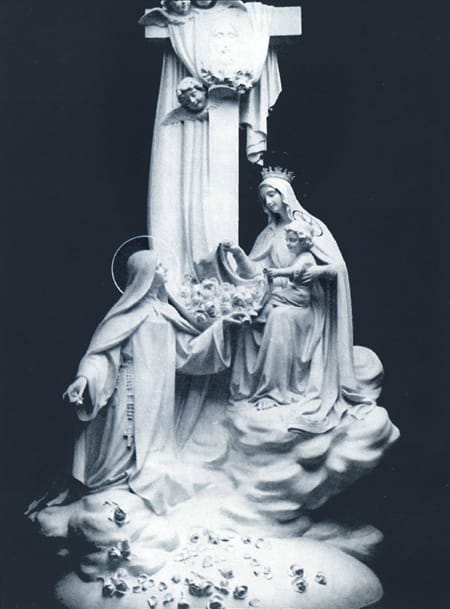 Few of Therese’s biographers have sufficiently emphasized the role Mary played in the development of the Little Way. For this reason, Therese is not perfectly understood and the very means of arriving at that simplicity, confidence and spiritual poverty which are the essence of her message may be overlooked. It is not that Therese herself failed to mention it. An earnest study of her autobiography, correspondence, poetry, her conversations and all the events of her life — reveals the tenderest devotion to Mary, a unique, singular devotion that surprises even those who think they know her best. More than this, they indicate something in her spirituality and teaching it were well worth our while to study in a new light.
Few of Therese’s biographers have sufficiently emphasized the role Mary played in the development of the Little Way. For this reason, Therese is not perfectly understood and the very means of arriving at that simplicity, confidence and spiritual poverty which are the essence of her message may be overlooked. It is not that Therese herself failed to mention it. An earnest study of her autobiography, correspondence, poetry, her conversations and all the events of her life — reveals the tenderest devotion to Mary, a unique, singular devotion that surprises even those who think they know her best. More than this, they indicate something in her spirituality and teaching it were well worth our while to study in a new light.
It goes without saying that Therese owes a great deal of her spirituality to her devoted and saintly parents, above all to her “incomparable father,” Louis Martin. In his youth, Louis had dreamed of becoming a priest, of “serving Our Lady” in a distant Swiss hermitage, but this was not God’s Will for him. Louis went to Paris as an apprentice watchmaker, where began that lifelong attachment of his to the shrine of Our Lady of Victories. Here in Paris he was given that lovely little statue, a copy of the Sulpician Madonna under whose shadow St. Louis Marie de Montfort had offered his first Mass 150 years before, that statue which was to become the family treasure and which was to smile upon his little Therese.
Louis never referred to Our Lord in conversation without adding Our Lady’s name — “Thanks be to God and His Blessed Mother,” he would say. And when he married Zelie Guerin he found in her a sweet echo of his own devotion to God’s Mother, for Zelie was a woman of remarkable faith. They lived in perfect chastity as brother and sister for several months after their marriage, in order to imitate the chaste union of St. Joseph and the Virgin. A priest counselled them to offer their love to God by giving Him many children, saintly children. And this they did. There were nine altogether, each one receiving “Marie” as a secondary name, even the boys, none of which, however, lived to maturity.
We might say that love of Mary grew as a second nature in little Therese. Marie, her older sister, writes to one of the cousins: “My month of May decorations at home rival those of the cathedral; at least I think so. It is a whole day’s work to fix them up. Mamma is more difficult to please than the Blessed Virgin. We must have flowers and white-thorn blossoms up to the ceiling, and all kinds of greenery for the background. Little Therese is delighted and claps her hands for joy, etc.” (Our Lady of the Smile and St. Therese of the Child Jesus, Rev. Stephane-Joseph Piat, OFM, pg. 10).
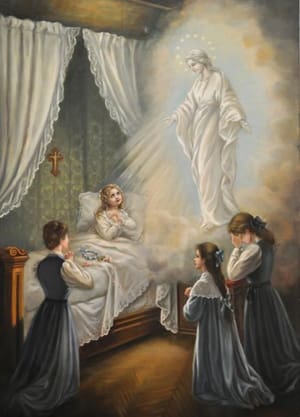 We cannot hope to do justice to Therese’s childhood devotion to Our Lady in a few short pages, but as it is vital to our understanding of her Little Way, perhaps a few excerpts from her writings at this time may help. On May 13, 1883, Therese was miraculously cured of a strange illness “in which Satan assuredly had a hand” and for which there was no human remedy. She tells us in her Autobiography: “Utterly exhausted, and finding no help on earth, I too sought my Heavenly Mother’s aid, and entreated her with all my heart to have pity on me… Suddenly the statue became animated and radiantly beautiful with a divine beauty that no words of mine can ever convey. The look upon Our Lady’s face was unspeakably kind and sweet and compassionate; but what penetrated to the very depths of my soul was her gracious smile. Instantly all my pain vanished, my eyes filled, and two big tears rolled down my cheeks, tears of purest heavenly joy…” (Autobiography, p. 66).
We cannot hope to do justice to Therese’s childhood devotion to Our Lady in a few short pages, but as it is vital to our understanding of her Little Way, perhaps a few excerpts from her writings at this time may help. On May 13, 1883, Therese was miraculously cured of a strange illness “in which Satan assuredly had a hand” and for which there was no human remedy. She tells us in her Autobiography: “Utterly exhausted, and finding no help on earth, I too sought my Heavenly Mother’s aid, and entreated her with all my heart to have pity on me… Suddenly the statue became animated and radiantly beautiful with a divine beauty that no words of mine can ever convey. The look upon Our Lady’s face was unspeakably kind and sweet and compassionate; but what penetrated to the very depths of my soul was her gracious smile. Instantly all my pain vanished, my eyes filled, and two big tears rolled down my cheeks, tears of purest heavenly joy…” (Autobiography, p. 66).
Therese prepared for her First Communion the following year in union with Mary. “O my beloved Mother, I confide to your care the little garden of my heart. Come to sow in it beautiful flowers of desires and acts which will be as ac radle of love for Jesus; and I wish it would make you forget the cold stable of Bethlehem” (Piat, p. 28).
Therese was admitted to the Sodality of the Children of Mary on May 31, 1886, and renewed her consecration to that Heavenly Mother in the prayer she composed. Note the similarity of expressions between it and the de Montfort consecration: “Henceforth I am determined to belong to you unreservedly, to walk in your glorious but humble footsteps, and to imitate your virtues, especially your angelic purity, your deep humility, your blind obedience, and your incomparable charity. I make these firm resolutions at the foot of your altar, and in the presence of the whole heavenly court” (ibid., p. 330). That Therese was familiar with de Montfort’s True Devotion to Mary is certain, but at what point in her life she came across it, we do not know.
Therese often renewed this consecration; to her it was no empty formula. Now the one burning desire of her heart was to enter Carmel, where she would more closely imitate Mary’s hidden life and clothe herself with her Mother’s virtues. During the pilgrimage they made to Rome, M. Martin took Therese and Celine to visit the Church of Our Lady of Victories in Paris. Here a special grace awaited her:
“It was there that my Mother, the Blessed Virgin, told me clearly it was really she who had smiled on me and cured me. With intense fervor I entreated her to guard me always, and to realize my heart’s desire by sheltering me under her virginal mantle! Ah, that was one of my first desires as a child. When growing up I had understood that it was in Carmel I could truly find that mantle of the Blessed Virgin, and it was to that fertile mountain all my desires tended” (Piat, p. 36).
Again, she writes, “I could not express what I felt at the feet of our Blessed Mother. Tears alone betrayed my happiness… I understood that she was watching over me, and that I was her privileged child; and so I wished to give her the name of ‘Mamma,’ for it seemed to me more tender than Mother” (Piat, pp. 3637). Her cherished dream was realized on April 9th, 1888, the day the Church was keeping the transferred feast of the Annunciation of the Virgin Mary, that sublime mystery of our Faith in which we see, as St. Louis de Montfort says, Jesus giving Himself without reserve to Mary and depending upon her for all things.
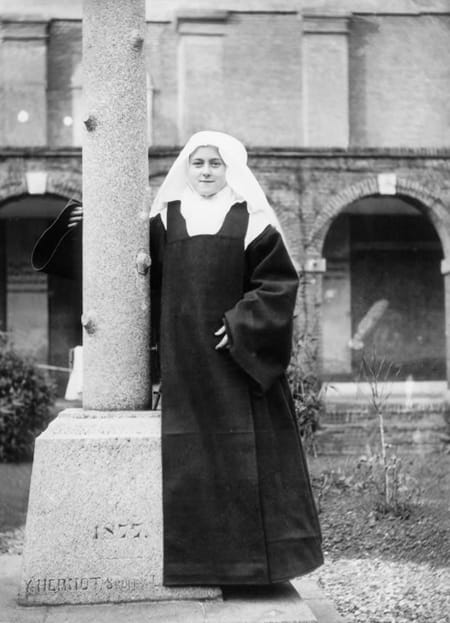 So far we have only “scratched the surface” of Therese’s Marian devotion. In Carmel her soul gradually detached itself from all that was not God, and Mary herself led the way. Hers was a contemplative soul of the highest type; she lived in the finer regions of purest faith, in the transcending realms of purest love. But Therese was no stranger to high mystical graces. One of these she received during the first year of her Novitiate, in July, 1889:
So far we have only “scratched the surface” of Therese’s Marian devotion. In Carmel her soul gradually detached itself from all that was not God, and Mary herself led the way. Hers was a contemplative soul of the highest type; she lived in the finer regions of purest faith, in the transcending realms of purest love. But Therese was no stranger to high mystical graces. One of these she received during the first year of her Novitiate, in July, 1889:
“It was as if a veil had been thrown over me hiding the things of earth. I seemed to be entirely hidden beneath the veil of the Blessed Virgin. At the time I had charge of the refectory, and I performed my actions as with a borrowed body. I remained in this state for an entire week. It is a supernatural state very difficult to explain. God alone can bring it about, and such a grace suffices sometimes to detach a soul forever from this world” (Piat, pp.43-44).
We follow Therese through her battles in Carmel — and battles they were! She conquered impatience and sensitivity. She was severely tempted against her vocation on the very eve of her profession. She fought weariness, dryness and fatigue. She waged a valiant war against her affections, clinging to the railing as she passed Mother Agnes’ door lest she give in to the too natural desire she had to speak with her… until, nature conquered, she began to love in and for God alone. Therese was a “war-horse” in the face of combat, and behind it all, the purest love drove her on and up, “swift and high.”
The essence of Therese’s doctrine is this: it is not we who are good, it is God Who is good. Our place is always littleness. And what is this “littleness?” It is our nothingness which dares to place unbounded confidence in the Merciful Love of the good God. Never must we be discouraged at our weakness – more, we must learn to love it, for the weaker we are the more claim we have upon that Mercy which is above all His works. Therese dared to call God her “Papa” — she dared to throw herself into His arms as a little child, and her “idea” has revolutionized the Christian world.
At first sight it may seem a new doctrine, but Therese’s Little Way is simply the inevitable consequences of the Incarnation, of our divine adoption as children of God. It is the transforming grace of the Incarnation which raises nothingness to the Divine. And in whom was the Incarnation more perfectly realized than in the Mother of God herself? She is the humblest of God’s creatures, in whom the Divine Mercy wrought unimpeded wonders. Her life was so simple, so hidden in God. She wrought no miracles, preached no sermons, left behind no lofty treatises. She lived by the loftiest faith — how Therese disliked to hear people say that Our Lady’s life was one continual miracle! “No, everything in their life was just as it is in ours!” And in this littleness, she finds the basis of her confidence, the recognition that before God all “greatness” is nothing and that in the evening of life it is love alone that counts.
Therese’s contemplation of the Incarnation led her to an ever greater intimacy with both the Mother and the Son. “Picturing my soul as a piece of waste ground, I beg Our Lady to take away my imperfections which are as heaps of rubbish…and beautify it with her own adornments…” “…Now I feel annoyed at nothing. I believe that the Blessed Virgin sees my good will and is satisfied with it… No sooner do I invoke her than she comes to my assistance. If I become anxious or annoyed about something, I run to her immediately, and without fail, as the most tender-hearted mother, she safeguards all my interests.”
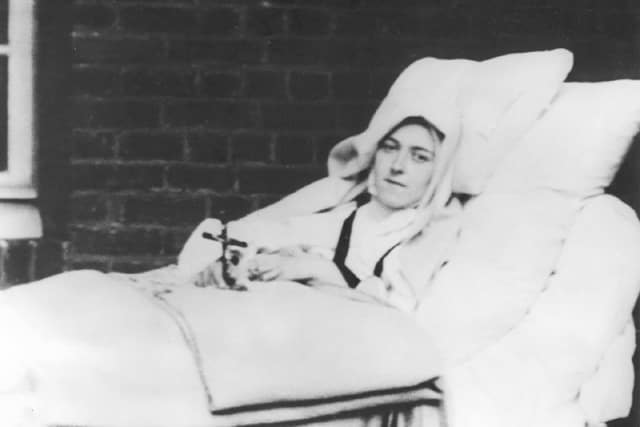 Whether she realizes it or not, Therese is echoing the finest passages of De Montfort’s classic on the True Devotion to the Blessed Virgin Mary, the devotion he called Slavery of Love. In fact, a close analysis of his doctrine and the Marian devotion of the Little Flower shows the most striking similarities. We gather that Therese did not care for the word “servant.” To her it would have seemed too aloof, too “mercenary.” “I am not the servant but the child of the Blessed Virgin.” St. Louis as well found this word inadequate. He used the expression “Slave of Love” only because he found no other word which would more adequately express the total dependence, the belonging, the offering of himself he wished to make to Jesus through Mary. Therese found that word — it was victim.
Whether she realizes it or not, Therese is echoing the finest passages of De Montfort’s classic on the True Devotion to the Blessed Virgin Mary, the devotion he called Slavery of Love. In fact, a close analysis of his doctrine and the Marian devotion of the Little Flower shows the most striking similarities. We gather that Therese did not care for the word “servant.” To her it would have seemed too aloof, too “mercenary.” “I am not the servant but the child of the Blessed Virgin.” St. Louis as well found this word inadequate. He used the expression “Slave of Love” only because he found no other word which would more adequately express the total dependence, the belonging, the offering of himself he wished to make to Jesus through Mary. Therese found that word — it was victim.
On June 9th, 1895, two years before her death, the saint offered the holocaust of herself to the Most Holy Trinity through her dearest Mother — “to her I commit this oblation, praying her to present it to Thee.” The “infinite desires” of her heart were realized in the oblation she made of her entire being to God’s Merciful Love, to be consumed as a victim, a martyr of soul and body to the Love of her childhood.
In May of 1897, her body consumed by tuberculosis, her soul crucified in the dark night of faith, Therese had “something to do” before her death. She must write down in a poem “what I would preach on the Blessed Virgin if I were a priest.” It is the flower of her contemplation, even as was Our Lady’s own Magnificat; aside from certain passages of her Autobiography, it is the most beautiful of her writings. As Therese meditated upon the touching Gospel scenes, it is clear that Our Lady had communicated her joys and sorrows, the mysteries of her life to this child, and in them Therese finds the answers for the most puzzling mysteries of her own, particularly in her bitter dark night of soul. The poem is entitled “Why I Love Thee, O Mary”:
“Since Heaven’s high King has willed it so,
His Mother and His dearest,
Should know the anguish of that night
The torn heart’s deepest woe,
Then are not those who suffer thus
To Mary’s heart the nearest?
And is not love in suffering
God’s highest gift below?
(Susan L. Emery translation)
Therese’s sufferings during the last months of her life were very great. Her last utterances gave vent to her ardent love for Our Lord and for His Mother, with whom she seemed to become more intimate as the vision of her mission grew brighter. “I should like to have a beautiful death, just to give you pleasure. I have asked this of the Blessed Virgin. To ask something of the Blessed Virgin is not the same as to ask something of the Good God. She knows well what to do with my little desires, and it is for her to decide whether to ask for them or not…” When questioned whether Our Lady was also hidden from her, she replied, “Oh, no, she is never hidden from me. And when I no longer feel the presence of God, I give all my commissions to Our Blessed Mother. I tell her, in particular, to remind Our Lord not to be afraid of sending me trials” (Piat, pp.83-85).
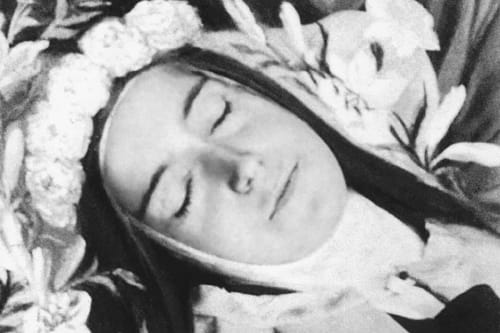 The evening of September 30th, 1897, was to be her last on earth. Her terrible agony had lasted for full twelve hours. A little after seven she turned to her Prioress, Mother Gonzague, and asked, “Mother, is not this the agony? Am I not going to die?… Very well, then, very well….be it so….Ah! I do not wish to suffer less.” And gazing at her crucifix, she went on, “Ohl!…I love Him!… My God, I…love… Thee!” “Scarcely had she spoken, when to our great surprise her whole frame drooped quite suddenly, the head inclined a little to the right… All at once she raised herself, as though called by a mysterious voice, and opening her eyes, which shone with unutterable joy, she fixed her gaze a little above the statue of Our Lady and so remained for about the space of a Credo, when her blessed soul was borne away to the heights of heaven…” (Autobiography, p. 240).
The evening of September 30th, 1897, was to be her last on earth. Her terrible agony had lasted for full twelve hours. A little after seven she turned to her Prioress, Mother Gonzague, and asked, “Mother, is not this the agony? Am I not going to die?… Very well, then, very well….be it so….Ah! I do not wish to suffer less.” And gazing at her crucifix, she went on, “Ohl!…I love Him!… My God, I…love… Thee!” “Scarcely had she spoken, when to our great surprise her whole frame drooped quite suddenly, the head inclined a little to the right… All at once she raised herself, as though called by a mysterious voice, and opening her eyes, which shone with unutterable joy, she fixed her gaze a little above the statue of Our Lady and so remained for about the space of a Credo, when her blessed soul was borne away to the heights of heaven…” (Autobiography, p. 240).
To her heavenly Mother, Therese had written:
“O thou who cam’st to smile on me at dawn of life’s beginning,
Come once again to smile on me, Mother! the night is nigh!
I fear no more thy majesty, so far removed above me;
For I have suffered sore with thee:
Now hear me, Mother mild!
Oh, let me tell thee face to face,
Dear Mary, how I love thee,
And say to thee forevermore:
I am thy little child.”
Our Lady had heard her prayer…
